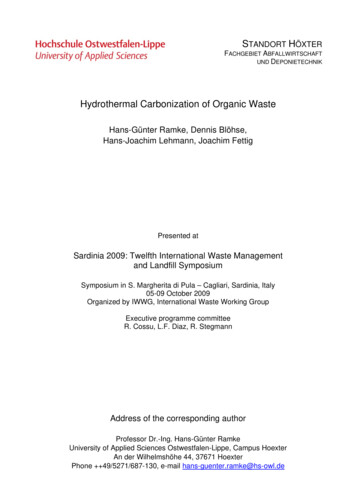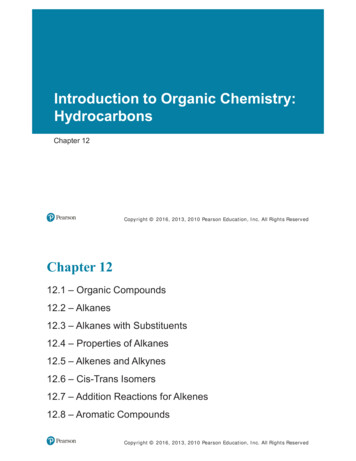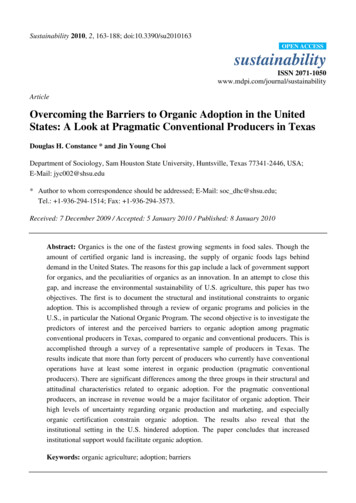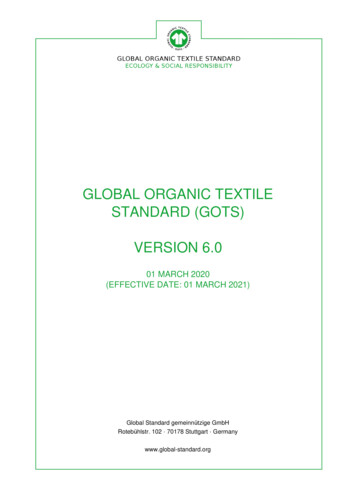
Transcription
STANDORT HÖXTERFACHGEBIET ABFALLWIRTSCHAFTUND DEPONIETECHNIKHydrothermal Carbonization of Organic WasteHans-Günter Ramke, Dennis Blöhse,Hans-Joachim Lehmann, Joachim FettigPresented atSardinia 2009: Twelfth International Waste Managementand Landfill SymposiumSymposium in S. Margherita di Pula – Cagliari, Sardinia, Italy05-09 October 2009Organized by IWWG, International Waste Working GroupExecutive programme committeeR. Cossu, L.F. Diaz, R. StegmannAddress of the corresponding authorProfessor Dr.-Ing. Hans-Günter RamkeUniversity of Applied Sciences Ostwestfalen-Lippe, Campus HoexterAn der Wilhelmshöhe 44, 37671 HoexterPhone 49/5271/687-130, e-mail hans-guenter.ramke@hs-owl.de
This paper can be cited as follows:RAMKE, H.-G.; BLÖHSE, D.; LEHMANN, H.-J.; FETTIG, J., 2009: Hydrothermal Carbonizationof Organic Wastein: COSSU, R.; DIAZ, L. F.; STEGMANN, R. (EDTS.), 2009: Sardinia 2009: Twelfth InternationalWaste Management and Landfill Symposium, Sardinia, Italy, 05-09 October 2009,Proceedings, CISA Publisher
HYDROTHERMAL CARBONIZATION OFORGANIC WASTEH.-G. Ramke*, D. Blöhse**, H.-J.Lehmann*** and J. Fettig** University of Applied Sciences Ostwestfalen-Lippe, Campus Höxter,An der Wilhelmshöhe 44, D-37671 Höxter, Germany** Max-Planck-Institute of Colloids and Interfaces, Research Campus Golm,D-14424 Potsdam*** Consulting Engineer, Fontanestraße 70, D-15366 NeuenhagenSUMMARY: Hydrothermal carbonization (HTC) is a chemical process which emulates thenatural coalification of biomass. But in difference to the natural process which requires somehundred (peat) to some million (black coal) years the hydrothermal carbonization only needs lessthan 12 hours for the transmutation of biomass into a material comparable to brown coal. TheHTC process is performed with biomass suspensions in a pressure vessel under temperatures of180 - 220 C and resulting water vapour pressures between 10 - 15 bars. Gas generation mayincrease the pressure up to more than 25 bars. After activation, HTC is an exothermic process.About one third of the combustion energy of the biomass is released.First experiments were carried out by BERGIUS (1913), who described the hydrothermalconversion of cellulose into coal-like materials, and systematic investigations were performed inthe nineteen-thirties. The process was rediscovered some years ago at the Max-Planck Instituteof Colloids and Interfaces in Golm/Potsdam (MPI), where comprehensive state-of-the-artexperiments helped to understand the process much more in detail.In co-operation with the MPI the University of Applied Sciences Ostwestfalen-Lippe startedthe first feasibility study on the HTC process using organic waste, funded by the DBU (DeutscheBundesstiftung Umwelt), in 2007. Within the scope of this project more than 100 carbonizationswere performed in a 25-litre pressure vessel.Many types of biomass including different organic wastes from households and industrieswere successfully carbonised. At the end of the process the solid phase, the “HTC-Biochar”, caneasily be separated from the water. Approximately 75 - 80 % of the carbon input is found in thesolid phase; about 15 – 20 % is dissolved in the liquid phase, and the remaining 5 % areconverted to gas (mainly carbon dioxide). The liquid phase is highly loaded with organiccomponents, which are easily degradable.Comparisons of the elemental composition (C/H/N/O) of input- and output-materials giveclear advice on the intensity of the carbonization process. Elemental composition and calorificvalue of most of the HTC-outputs are very similar to brown coals. Therefore the HTC-Biocharsmight be of interest for energy production. Brown coal could be replaced partly by convertedorganic wastes, or the HTC-Biochar could be incinerated in specialised cogeneration plants.Apart from energetic use HTC-Biochar could be of interest as soil additive due to itsstructural texture. First investigations on applications in soils were performed, too.HTC is a promising technology for conversion of organic wastes with high water contents andmight become of importance also for CO2-sequestration.
1. INTRODUCTIONHydrothermal carbonization (HTC) is a chemo-physical process for the conversion of organicmaterial (biomass). HTC is based on the natural process, coalification of organic material, whichhas taken place under geological influences mainly in the Carboniferous. The fundamentalscientific knowledge base was compiled by FRIEDRICH BERGIUS over 100 years ago (seeBergius, 1928).Hydrothermal carbonization is understood to be the coalification of organic material inaqueous phase under applied high temperatures and pressure. This process, the refinement ofbiomass, having lain forgotten for a long time, has been re-discovered and further developedunder the direction of Professor ANTONIETTI, director of the Department of Colloid Chemistry atthe MAX-PLANCK INSTITUTE of Colloids and Interfaces in Golm/Potsdam (MPI). The earlierdescribed processes could now be accurately controlled using modern instrumentation andsupported by catalysts (Titiric et al., 2007a).For hydrothermal carbonization to take place, plant-based products such as leaves, straw,grass, wood chippings or fir cones are placed in a pressure vessel together with water and asuitable catalyst. The reactor is then closed, and under air-exclusion is heated under pressure.The HTC process generally takes place at temperatures between 180 C and 220 C over a 4 to 12hour period, after which, the mixture is cooled down and the vessel is opened: It now contains ablack watery fluid comprised of finely dispersed spherical carbon particles (colloids). Carbonwhich was formerly bound in the organic material now lies in front of us in particle form assmall, porous brown-coal spherules.The resulting HTC-Biochar can be incinerated or can be further utilized industrially likebrown-coal is used. An example might be conversion via the FISCHER-TROPSCH-synthesis intopetrol. Hydrothermal carbonization is not a fast process; thus during the reaction, interesting byproducts such as peat or humus can be gained and consequently used for soil improvement. Thespecial structure of HTC-Biochar makes possible its use for example as absorption and/orseparation media (Titirici et al., 2007b).Hydrothermal carbonization is based on a simple chemical process; namely the splitting ofwater from carbohydrates (dehydration):C6H12O6CarbohydrateHTC “C6H2O““HTC-Biochar“ 5 H2OWater 950 kJ/molHeatA simple energy balance of this process already indicates that it is exothermic; during thereaction, energy is released (Titirici et al., 2007a). However, before this energy can be utilized, amound of activation energy has to be overcome; it is thus necessary to heat the reactor vessel upto at least 180 C. The reaction proceeds within a few hours, whereby the degree of dehydrationof the carbohydrates is dependent upon the duration of the reaction. Detailed research confirmsthat additives can support and accelerate the reaction.It must be emphasized, that all these conversions – suitably controlled – proceed with only avery slight loss of carbon in the solid phase and therefore the process works with high carbonefficiency. Additionally, the carbonization process is an exothermic reaction and thus the energyneeded for the conversion can be obtained or is perhaps exceeded. The HTC-process couldtherefore be superior to other methods of energy production from biomass.A further advantage of hydrothermal carbonization is that the liquid phase can be separatedconsiderably more efficiently from the HTC-Biochar than from other biomass. The net calorificvalue of the product referred to the input is therefore, despite the losses during the conversion,often higher than that of other materials which first have to be expensively dewatered or dried.
2. CURRENT STATE OF RESEARCH2.1 Project OverviewThe idea, hydrothermal carbonization, was taken up by the working group “Waste Managementand Landfill Technology” at the University of Applied Sciences Ostwestfalen-Lippe(Hochschule Ostwestfalen-Lippe, HS-OWL) in Hoexter, Germany, in mid-2006 after a pressarticle about HTC. The first step in the form of a student’s project assignment was to researchthe basic qualitative applicability of the method. The positive findings of this research formedthe basis of a research proposal to the DBU (Deutsche Bundesstiftung Umwelt, Federal GermanFoundation for the Environment) requesting support for a feasibility study which would beundertaken in co-operation with the Max-Plank Institute in Golm.The DBU project was carried out between July 2007 and June 2009 under the heading:Feasibility Study into Energetic Use of Organic Municipal Solid Wasteby Hydrothermal CarbonizationThe project work was carried out in the form of four integrated assignment blocks:1. Waste management research and project coordinationHS-OWL, Campus Hoexter, Waste Management and Landfill TechnologyProfessor Dr.-Ing. Hans-Guenter Ramke2. Basic scientific support regarding carbonizationMax-Plank Institute of Colloids and Interfaces, Golm/PotsdamProfessor Dr. Markus Antonietti, Director, Department of Colloid Chemistry3. Consultancy in process-technology considerationsDr.-Ing. Hans-Joachim Lehmann, Dipl.-ChemistConsulting Engineer, Neuenhagen, Berlin4. Handling of wastewater treatment problemsHS-OWL, Campus Hoexter, Water TechnologyProfessor Dr.-Ing. Joachim FettigHydrothermal carbonization of municipal solid waste stood in the foreground within the frame ofthe DBU-sponsored project. Hydrothermal carbonization of other materials such as sewagesludge or biogas slurry has been followed in smaller parallel projects.2.2 Test Equipment and Study ProgramThe autoclave (pressure-vessel) situated in the Laboratory of Waste Management and LandfillTechnology has a 25-litre capacity and was formerly used to determine the water absorptioncapacity of concrete test blocks. Since the beginning of the project, it has been re-fitted andequipped with computer supported PLC. Figure 1 shows the re-fitted autoclave.Since the start of project, well over 100 tests have been carried out and the resulting productsanalyzed. The tests have been carried out as batch-tests, with and without the use of an openinner vessel. Stirring the suspension is not possible.The physical parameters temperature, pressure, and energy consumption are continuallyrecorded. The resulting gas is captured, and after the carbonization the HTC-Biochar isdewatered.
Figure 1: Autoclave with switch panel and VDU workstationThe following analyses were carried out regularly:-Gas production potential of the inputComposition of the inputComposition of the solids (“HTC-Biochar”)Analyses of the liquid phaseAnalyses of the gas phaseThe dewatering and drying properties of the HTC material are consequently studied with teststands developed for this purpose.2.3 Investigated Input MaterialIn Figure 2, potential hydrothermal carbonization input material has been compiled relative to itsconsistency and origin. The input material investigated under the terms of the feasibility study isshown against a grey background.Within the frame of the DBU-Project, the material shown below was used and analyzed:- Standard substrate:--- Maize silage and dried sugar beet pulp (Standard I)- Biogas slurry, straw and dried sugar beet pulp(Standard II)Mono substrate:- Sugar, starchMunicipal waste:- Fresh compost, organic waste (“Green Bin”)- Green cuttings (grass and bush cuttings)- LeavesCommercial and industrial waste - Citrus peel, food waste, brewer grainsAgricultural residues:- Straw, liquid manureMiscellaneous residues:- Biogas slurry from biogas production- Sewage sludge from municipal sewage treatment plants
Figure 2: Overview of potential input material for HTC2.4 Characteristics of HTC-BiocharFigure 3 gives an impression of the appearance of dried HTC-Biochar. Typical, is the browncolour after drying. The porous structure is only revealed by high magnification. Visuallynoticeable are plant structures which are often still recognizable after the carbonization despitehaving undergone an extensive material transformation.Figure 3: Dried HTC-Biocharfrom Standard 1 (Dried sugarbeet pulp and maize silage)
The bulk density of the dried HTC-Biochar is low. The danger of a dust explosion orspontaneous combustion following total drying out, cannot be excluded. The material thereforeshould not be totally dried out before burning.2.5 Process ParametersThe test series have not only been carried out in accordance with the numerous publicizedstandards for hydrothermal carbonization; namely a temperature of ca. 180 C over reaction-timeperiod of 12 hours, but also carried out under optimized conditions.Figure 4 shows exemplarily the process parameters (outer casing and internal pressure-vesseltemperatures, energy input of the heating circuits and internal vessel pressure) over the durationof a selected test run under standard conditions. The rise in internal vessel pressure illustratedhere indicates the magnitude of the reaction processes causing gaseous reactions’ products(dominantly CO2).HTC - Test RecordStandard 2008 05 08220Temperature [ C]; Heat Energy 40Pressure [bar]Vessel TemperatureCasing Temperature1. Heating Circuit -1.5 kW2. Heating Circuit -3.0 kWPressure2400012345678910 11 12 13 14 15 16 17 18 19 20Test Duration [h]Figure 4: Process Parameters of a typical HTC – ExperimentIn pursuit of optimizing the process conditions, the temperatures of the reaction have beenvaried. In particular, the temporal adaptation of the reaction temperatures to the carbonizationprocess led to a marked intensification of the processes and to a significant reduction of thereaction time. The process-linked temperature regulation subsequently led to an improvement tothe properties of the HTC-Biochar. Precisely, the fuel qualities (C-content, calorific value) of theHTC-Biochar can be positively influenced. Furthermore, it has ascertained that, in the catalyzingeffect of additives there is a significant potential available for the intensification and steering ofhydrothermal reactions.
3. MASS BALANCES AND PROPERTIES OF HTC-BIOCHARS3.1 Mass and Carbon BalancesThe mass balances of the in- and output masses showed an average recovery ratio of ca. 97 % intotal. The losses can be plausibly explained as wetting, evaporation and so-called spill- ordroplet-losses.Differentiation of the mass balance with regard to the dry and wet mass indicates that throughchanges during the hydrothermal reaction of the biomass, the dry mass is reduced whereby, inpart, more water than at onset is found. This shows that as a consequence of dehydration duringthe process, water is generated. The reduction in the dry mass is in addition to dehydrationcaused by decarboxylation (the split-off of carbon dioxide).In analogy to the mass balances, the recovery-value of organic carbon is 95% and more. Thedistribution of the carbon fractions in the solid, liquid and gaseous phases is dependent on thevarious types of substrates. However, the tendency is apparent as Table 1 indicates.Table 1: Distribution tendencies of the carbon fraction in the HTC product phasesSubstrateC – Solid Phase[%]C – Liquid Phase[%]C – Gas Phase[%]Organic waste74.919.06.1Green Cuttings75.319.75.0Biogas Slurry72.222.15.7Straw75.419.74.9Chipped Wood82.914.13.0In the tests thus far, 75 – 80 % of the input carbon is regained in the solid phase, wherebynormally (without controlled recirculation) about 15 – 20 % of the organic carbon are transferredinto the liquid phase. About 5% of the carbon is released as gas.3.2 Extent of CarbonizationThe hydrothermal carbonization process can be well visualized by way of the coalificationdiagram (Figure 5). In the coalification diagram, the mol ratio hydrogen/carbon within a solid ispresented vs. the oxygen/carbon mol ratio (see Behrendt, 2006).During the course of carbonization, the process goes from cellulose and wood, via the interimsteps peat and lignite, to the various forms of brown coal, through to coal and anthracite. In thecarbonization diagram, the mol ratio H/C to O/C moves from upper right to lower left as thecarbonization advances.Therefore the degree of carbonization can be shown very descriptively in the coalificationdiagram for any HTC-Biochar. Additionally, the intensity of the process is shown by the lengthof the vector, starting at the input analysis and ending at the output analysis.In Figure 5, the test results for a broad spectrum of input materials are presented. With regardto organic waste (“Green Bin”), in case of food waste and also sewage sludge the area of browncoal has not been “fully reached”, because of their relatively high H/C mol ratio; but the lengthof the input-output vectors show that the materials have reacted intensively.
Diagram of Coalification1.8Crude OilQuarter IV/20082.0CelluloseOil ShaleH/C [Mol Ratio]1.41.2Asphalt & Bitumen1.6WoodBituminousBrown CoalPeatLignin1.0Lignitic Brown CoalBrown CoalLigniticBlack Coal0.8Brown Coal ReferenceBlack Coal0.60.4Anthracite0.2Organic WasteFood WasteBush CuttingsLeavesBiogas SlurryBrewer GrainsStrawChipped WoodPrimary SludgeDigested SludgeStandard IICitrus O/C [Mol Ratio]0.91.01.1Structure acc. to BEHRENDT, 2006Figure 5: Example of a carbonization diagram (Tests IV Quarter/2008)3.3 Fuel CharacteristicsAnalyses of the element contents and gross calorific values of HTC-Biochars enables assessmentof the resulting HTC-Biochar fuel characteristics against the brown coal characteristics. Figure 6illustrates the gross calorific values and carbon content of HTC-Biochar, compared against the‘Lausitz’ brown coal (LAUBAG-Briquet) reference point.Figure 6 shows the significant correlation between the carbon content and the gross calorificvalue of the materials tested by the Laboratory of Waste Management and Landfill Technology.In addition, it can be clearly seen that most of the HTC-Biochars tested here, with regard to Ccontent and calorific value, can be classified as being similar to brown coal. Determinative forthe gross calorific value are the concentrations C, H, N and O which are also entered in thetheoretical calculation of the calorific value, (e.g. in the approximation of BOIE).In all tests, a significant increase in energy density could be confirmed. In the Carbon Contentvs. Calorific Value Diagram the resulting vectors connecting input material to output materialwould be directed from lower left to upper right thus displaying the increasing carbon contentand calorific value.
Correlation Carbon Content - Calorific ValueQuarter IV/200840,000Gross Calorific Value (Ho) [kJ / kg DS]35,00030,00025,000y 398.7x 437.88R2 0.939920,000Brown Coal Reference15,00010,0005,000Organic WasteFood WasteBush CuttingsLeavesBiogas SlurryBrewer GrainsStrawChipped WoodPrimare SludgeDigested SludgeStandard IICitrus FruitsLAUBAG-BriquetLinear (HTC-Biochar)00102030405060708090100Carbon Content [%]Fig.6: Example of a Carbon Content - Calorific Value Diagram (Tests IV Quarter 2008)4. ENERGY BALANCES OF THE HTC PROCESSESBy comparing the energy content of the input and output material using the gross calorificvalues, it could be determined that 60 – 90% of the gross calorific value of input solids areavailable in the solid HTC-outputs (HTC-Biochar). The remaining energy is released as heatduring the exothermic process of carbonization or is chemically bonded in carbon compoundsdissolved in the liquid phase. The magnitude of the released heat is once more an indication ofthe intensity of the process, and is determined by the input material and also the processconditions.In the case of Standard 1 Material, that was so defined in order to test the reproducibility ofthe measurements and to optimize the test conditions using identical material, a release of energyof 4,300 – 5,700 kJ/kg DS (input material) was determined. This corresponds to about 30 % ofthe calorific value of the input material.By direct measurement of energy consumption these values could be approximatelyconfirmed. By applying calibration standards (water), the heat losses at defined temperatures dueto radiation and convection from the autoclave were measured. For this purpose, the electricityconsumption, recorded at intervals, was integrally calculated. The same calculation of energyconsumption was performed for the carbonization tests. The energy consumption required tomaintain the reactor temperature was, during the carbonization process, significantly lower dueto heat emitted from the exothermic processes within the reactor.
Evaluation of the tests on Standard 1 substrate showed an average release of energy of7,000 kJ/kg DS. Considering the inadequate insulation of the reactor in comparing reactor masswith the small solid mass of the tested material, the concurrence between the two independentassessment methods can be said to be good.For an exact determination of the heat of reaction, and in order to gain the data for a transferfrom the laboratory to a large scale facility, measurements from a continually working and betterinsulated reactor are absolutely necessary.5. DEWATERING AND DRYING PROPERTIES OF HTC-BIOCHARTotal Volume of Discharge [% Water Mass]The advantages of HTC for energetic use of organic wastes with high moisture contents can onlybe assessed if the complete process chain of conditioning and utilization is considered.It is therefore necessary to scrutinize the dewatering and drying properties of HTC-Biochar.Special test equipment has been developed for this purpose. Dewatering tests are oriented on theusual techniques for sewage sludge dewatering. By using a press, normally used for testingbuilding material, a cylinder filled with wet HTC-Biochar is put under a constant pressure of 15bars. The discharge of water is passed over a filter plate and caught in electronic scales.Figure 7 illustrates the progress of discharge of water against time (curves of total volumerelated to the original mass of water).100.090.080.070.060.050.040.0Straw, 16.06.2008Straw, 18.06.2008Organic Waste, 27.06.2008Standard II, 0Test Duration [min]Figure 7: Examples of development of discharge in dewatering tests with various substratesComparison of the curves of discharge enables an assessment of the dewatering properties of thedifferent materials at start and after hydrothermal carbonization under varying processconditions. Analogies with sewage sludge indicate that dewatering properties of sewage sludgeafter carbonization are actually much better than that of non-carbonized sewage sludge. Thisleads one to expect that this also applies to other wastes with high moisture contents.
The tests on the dewatering properties are supplemented with tests on the drying properties. Thetests are performed in an enclosed test cell, in which warmed air is passed over a 30 by 30 cmtest sample. For the determination of evaporation once again electronic scales are used, uponwhich the test sample lies. By comparing the evaporation behavior of different HTC-Biochars, itis possible to make relative conclusions about the drying properties. In the course of further testwork, the measurements will be calibrated against those from natural brown coal.It will thus become possible to replicate the complete process chain for the conditioning ofHTC-Biochars for energetic use under reproducible conditions.6. ANALYSES OF THE LIQUID AND GAS PHASES6.1 Liquid PhaseAnalyses of the liquid phase – of the process-water – showed, that the filtrates are predominantlyacidic. The organic contamination, substrate and process dependent, lay between 10,000 –40,000 mg/l in regard to BOD5 and between 14,000 – 70,000 mg/l for COD. The filtrate of HTCtests with the Standard I had an average COD/TOC-ratio of 2.30.The suitability of different treatment technologies for elimination of dissolved organiccompounds was tested: Iron-salt flocculation and adsorption onto activated carbon as well asaerobic biological treatment as single-step or in combination with a subsequent adsorptive stage.Expectedly, the first aerobic tests on degradability by the working group “Water Technology”at the University of Applied Sciences, HS-OWL, indicated that the liquid phase of the HTCprocess can be definitively biodegraded.Also, anaerobic decomposition tests (gas generation tests acc. to VDI 4630), carried out in theLaboratory for Waste Management and Landfill Technology, once more confirmed the gooddegradability of the dissolved organic components in the liquid phase. The gas potentialobserved in these experiments which, dependent upon substrate, could not be categorized asinsignificant appeared to be an interesting side-effect of the HTC processes. Consequently,utilization of the liquid phase is worth consideration.For the assessment of the aerobic biodegradability, a continuously working laboratorywastewater treatment plant turned out to be more suitable than batch tests. Figure 8 shows theset-up of the laboratory treatment plant, and Figure 9 the efficiency of degradation, determinedusing this test equipment. The efficiency of COD-degradation was about 85 %. The sametreatment installation shall also be used for future tests on the aerobic degradability afteranaerobic pre-treatment.The remaining substances after the aerobic treatment are strongly adsorbable on activatedcarbon. The samples presented in Figure 10 illustrate, that the content of organic materials canbe removed down to a few mg/l by contact with powdered activated carbon.6.2 Gas PhaseAs has been shown in Table 1, 3.0 – 6.1 % of the input carbon is transferred into the gas phase.Due to the aforesaid process of decarboxylation, CO2 is predominantly detected in the gas phase.The concentration of CO2 lies around 70 – 90%, dependent on substrate and reactivity.Furthermore a not insignificant concentration of hydrocarbons has been partially measured.Here, the spread of hydrocarbon traces lay between 1 – 4 % to 10%.
Figure 8: Laboratory treatmentplant for aerobic dynamicdegradation tests9000Figure 9: Influent andeffluent CODconcentrations in anaerobic dynamicdegradation test8000COD luent4000300020001000001020304050Test Duration [d]VersuchstagFigure 10: Biologically pre-treated samplesbefore and after adsorption onto powderedactivated carbon
7. SUMMARY OF PRESENT RESULTSThe results from the present project “Feasibility Study into Energetic Use of Organic MunicipalSolid Waste by Hydrothermal Carbonization”, sponsored by the DBU, can be summarized asfollows:- The carbonization of most of the input material was successful. Comparison of the elementalcomposition (C/H/N/O) of the input- and output-materials, gives a clear view into the extentto which carbonization was successful.- At the end of the process the solid phase, the “HTC-Biochar”, can easily be separated fromthe water. Approximately 75 - 80 % of the carbon input is found in the solid phase; about 15 –20 % is dissolved in the liquid phase, and the remaining 5 % are converted to gas (mainlycarbon dioxide).- The produced materials, HTC-Biochars, are deemed to be ‘brown coal-like’ with regard totheir elemental composition and calorific value.- After carbonization, the liquid phase is highly loaded with organic components, which areeasily degradable. The liquid phase has high TOC and COD content which, on average, laywell above 10,000 mg TOC/l and 15,000 mg O2/l with regard to COD.- Contained in the liquid phase, as a reaction-product, was a not-insignificant concentration oforganic acids, which according to present knowledge, is anaerobic degradable. By thesemeans, an energetic utilization of the liquid phase in the form of Methane (CH4) is possible.- The volume of released reaction-gas laid in the magnitude of ca. 50 – 100 l/kg DS. Thereleased gas is predominantly carbon dioxide.- An energetic advantage of hydrothermal carbonization is seen in the heat emission duringproceeding reactions. Evaluation of carbonization tests performed show, that with standardsubstrates, ca. 5 MJ/kg DS of the input materials are released as energy during the processes.- A further deciding advantage of the treatment of organic waste with high moisture content byHTC methods will be seen in the significant improvement of the dewatering properties of theresulting suspension (water-carbon-mixture). Tests on the ‘dewatering-behaviour of HTCOutput-Material’ have positively confirmed the improved solid-liquid-separation.8. OUTLOOKResearch activities in the field of Hydrothermal Carbonization are continued by the workinggroup “Waste Management and Landfill Technology” with two recently started projects, bothfocussing on practical application:- The Federal Ministry of Scientific Education and Research is promoting the project“Improved Energetic Use of Industrial Waste by Hydrothermal Carbonization” commencingsummer 2009.Within the frame of this project, a “semi-continuously working” reactor with a volume of200-litres is to be built. Combustion tests of HTC-Biochars are planned.- The DBU is to finance a new research project “Soil Improvement and Carbon Sequestrationby Applying HTC-Biochars from Organic Waste on Agriculturally Used Areas.”The project is to be carried out in co-operation with agricultural scientists under the directionof the “Institute for Sugar-Beet Research” at Goettingen University.
ACKNOWLEDGMENTSThe project was financially supported by the DBU – Deutsche Bundesstiftung Umwelt (GermanFederal Foundation on the Environment).REFERENCESBehrendt, F., 2006: Direktverflüssigung von Biomasse – Reaktionsmechanismen undProduktverteilungen, Institut für Energietechnik, Technische Universität BerlinStudie im Auftrag der Bundesanstalt für Landwirtschaft und ErnährungProjektnummer 114-50-10-0337/05
HTC is a promising technology for conversion of organic wastes with high water contents and might become of importance also for CO2-sequestration. 1. INTRODUCTION Hydrothermal carbonization (HTC) is a chemo-physical process for the conversion of organic material (biomass). HTC is based on the natural process, coalification of organic material .










